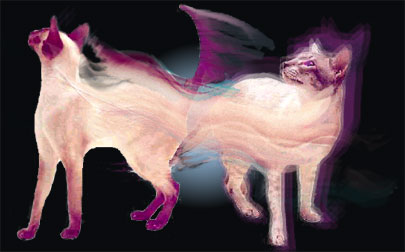Cat Scam

A little company in Sausalito, CA called Genetic Savings and Clone and its CEO Lou Hawthorne have had a busy couple of weeks. Early this past June two kittens, Tabouli and Baba Ganoush, were born to separate mothers in what the company calls the first successful commercial clone experiment. There was an earlier clone named Calico born two years ago who remains in the study.
This past week the kittens were introduced to the press and appeared on Good Morning America with a beaming Hawthorne acting more like the proud father than a triumphant CEO.
The kittens are the first of a short list to be produced this year in GSL's bid for commercial success in the science fictionesque business of manufacturing pet clones for a clientele willing to pay $50,000,the company currently has 5 paying customers.
The prospect of cloning has spawned considerable debate in the past few years. Announcements like that of the first cloned sheep "Dolly", who died prematurely in February 2003 of organ failure, fuel the controversy and, it should be said, that Hawthorne and Genetic Savings continue to fan the fire. Their web site features a section of affidavit's from ethics scholars and scientists largely concerned that pet cloning is bad science at best, ethically unsupportable at worst.
Genetic Savings publishes their detractor's sentiments in the wan hope that an American public so befuddled by science and the need for immediate gratification will not be able to decearn the straight forward fact that cloning is a carnival side show, a Barnum Bailey ruse designed to mine the pockets of distraught pet owners.
In order to clone a cat a Genetic Savings veterinarian removes skin cells from the donor cat, then using a proprietary technology called chromatin transfer or CT to remove the "adult characteristics" of those cells, essentially regresses them to an embryonic state.
Researchers then remove the genetic material from another cat's egg and inject the donor cell into the egg, stimulating it to produce a single-celled cloned embryo. The embryo then is implanted into a surrogate mother cat in estrus. The surrogate mother carries the pregnancy for the regular two month feline gestation period.
Cloned animals are genetic duplicates of the single parent donor at a the time of conception. However, genetic identity is not, and does not ensure, physical identity; the difference between the two is significant. Environment and socialization factors now come into play; the resultant individual may diverge greatly from the single parent.
Ethitists have suggested that the cost in animal suffering raised by this new technology including forced surrogation and multiple birth defects ending in premature death hardly commends this enterprise as an undertaking for the welfare of animals or man.
Ultimately we are left with this final consideration, no matter what trait of personality earns our love of a pet, its' obedience, its' obstinacy, its' beauty or homeliness, some flaw in its' character or some perceived grace, we tend to bond with an animal through our shared common experience, a history that can not be duplicated, nor should it be.













0 Comments:
Post a Comment
<< Home